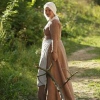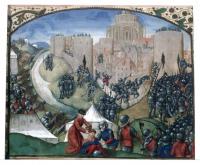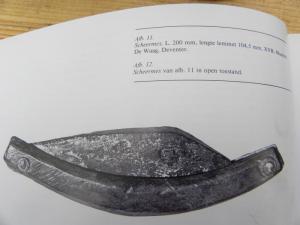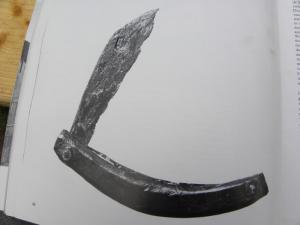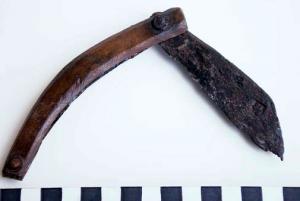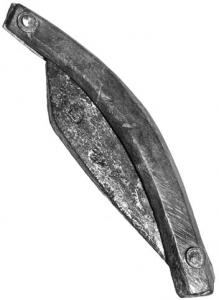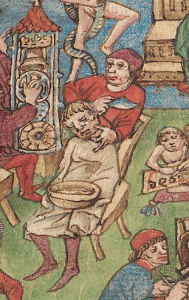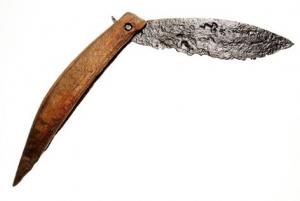#1

Опубликовано 21 Сентябрь 2011 - 11:57
Хочется заиметь себе аутентичную бритву, дабы не пользоваться богомерзким пластиком. Однако с источниками как-то туговато - никак не могу найти. Может, уважаемое сообщество поможет?
Зона непосредственного интереса - вторая половина 15 века, Бургундия-Франция-Нидерланды.
Хотя, источники на другие века и регионы тоже интересны.
#3

Опубликовано 21 Сентябрь 2011 - 16:10
Многие обеспеченные господа имели своих цирюльников.Например, Стоноры и Пастоны.В их переписке можно найти упоминания о покупке бритв и оплате личным цирюльникам.Не говоря о том, что это были очень доверенные люди, т.к. можно и до смерти забрить, а уж в Войну Роз...
(1467) Paston 2.567: Harry Wynstall, hys barbour, came yn-to his chambre and shaved hym.
Гарии Виндстол, его цирюльник вошел в комнату и побрил его(Пастона).
(1463-4) Acc.Howard in RC 57 244: For shavynge off my mastyr, ij d.
Из Счеотов Говардов: За бритье моего господина 2 пенса.
(1463) Acc.Howard in RC 57 215: Item, to Fynche the same day ffor ij rasorys, viij d.
Из Счетов Говардов: Означенному Финчу за 2 бритвы - 8 пенсов.
То есть одна бритва стоила 4 пенса.
Ежедневный заработок квалифицированного ремесленника составлял 4 пенса в день, у неквалифицированного – 2 пенса и у лучника, например - 6 пенсов.(Гарри Эмблтон)
(a1474) Paston 2.360: Item, a rosour.
Бритва.
(1440) PParv.(Hrl 221) 424: Rasoure, knyfe [vr. rasour of schavynge]: Novacula, rasorium.
В описаниях также встречается специальная одежда для цирюльников и прочие аксессуары:
(1440) PParv.(Hrl 221) 444: Schave, or schavynge knyfe: Scalpellum.
Бритва или бритвенный нож: скальпеллум
?c1475 *Cath.Angl.(Add 15562) 112a: A Schavyngeknyfe..scalprum.
Бритвенный нож...скальпрум.
(1446) Will York in Sur.Soc.45 102: De ij barbour myrors ij d.
Завещания города Йорка:2 цирюльных зеркала за 2 пенса.
(1451) Will York in Sur.Soc.45 118: De vij shavyng-clothes
Завещания города Йорка: "одежда для бритья".Тут видимо имеется ввиду, как раз специальная рабочая одежда цирюльника.Фартук или что - то такое.
(1446) Invent.Lytham in Chet.n.s.60 82: Also j shavyngbassyn.
Также ванночка(тазик) для бритья.
(1356) Doc.in Riley Mem.Lond. 283: [8 pairs of] kemstercombes [and one] boweshawe.
8 пар (...) расчесок и одна изогнутая бритва.
Термин boweshawe попадается в источниках, видимо как раз имеется ввиду форма бритвы.
Kunstwerk: Schmiedearbeit ; Geräte Haushalt ; Messer , Rasiermesser
Dokumentation: 1400 ; 1500 ; St. Pölten ; Österreich ; Niederösterreich ; Niederösterreichisches Landesmuseum ; IN 944

Изображение бритв также можно встретить на полотнах с темой "Обрезание".
Kunstwerk: Temperamalerei-Holz ; Einrichtung sakral ; Flügelaltar ; Niederösterreich ; Lk:02:021-038
Dokumentation: 1495 ; 1500 ; St. Pölten ; Österreich ; Niederösterreich ; Niederösterreichisches Landesmuseum Dauerleihgabe des Kunsthistorischen Museums Wien
Beschneidung Christi

Kunstwerk: Schmiedearbeit ; Geräte Haushalt ; Rasiermesser ; Deutschland
Dokumentation: 1495 ; 1505 ; Wien ; Österreich ; Wien ; Museum für angewandte Kunst ; F 736

Судя по изображениям в регулярной армии также присутствовали врачи-цирюльники:
Auteur, titre : flavius josèphe, guerre des juifs (trad. anonyme)
Titre d'usage :
Nom de pays : belgique
Origine : gand
Siècle : 15ème siècle
Date : 1480
Artiste : maître du boèce flamand
Средневековая Кухня Западной Европы http://vk.com/medieval_cuisine
#4

Опубликовано 21 Сентябрь 2011 - 21:28
#5

Опубликовано 12 Ноябрь 2012 - 00:09
In 15th century Europe, straight razors were used that didn't differ much from ours, including the hinge. See the pictures for an example that was found in a 15th century waste-pit in the city of Deventer. There's also a contemporary descriptive handwriting of razors that says:"Die sceersen om te barbieren wt Almaengien getekent metter sterren ende metter ekelen zyn de beste."
In English:"The razors (or blades) for shaving (barbering) from Germany marked with stars or with acorns are the best."
The star can be seen in the picture, just below the crook in the back. Like the acorn, it's a smith's mark and a sign of quality.
The dimensions of the blade are:
total length: 200 mm
blade lenth: 104.5 mm
blade width: 24.2 mm
blade thickness at the back: 8.8 mm
It's made of non-stainless steel, the same as that used for making swords. Men did shave themselves, but only when necessary. Monks shaved eachother and french knights shaved before battle. That might seem strange, but keep in mind that the enemy would slice your throat if they captured you and you didn't look like you're worth very much. Better have a shave and a clean shirt... Medieval folk shaved regularly up to the 16th century, when beards came info fashion again. During the middle ages (500-1500), they shaved according to fashion.
Средневековая Кухня Западной Европы http://vk.com/medieval_cuisine
#6

Опубликовано 05 Август 2013 - 11:14
Средневековая Кухня Западной Европы http://vk.com/medieval_cuisine
#7

Опубликовано 30 Июль 2015 - 17:27
Средневековая Кухня Западной Европы http://vk.com/medieval_cuisine
Также с меткой «бритва, 15 век, гигиена»
0 пользователей читают эту тему
0 пользователей, 0 гостей, 0 невидимых




